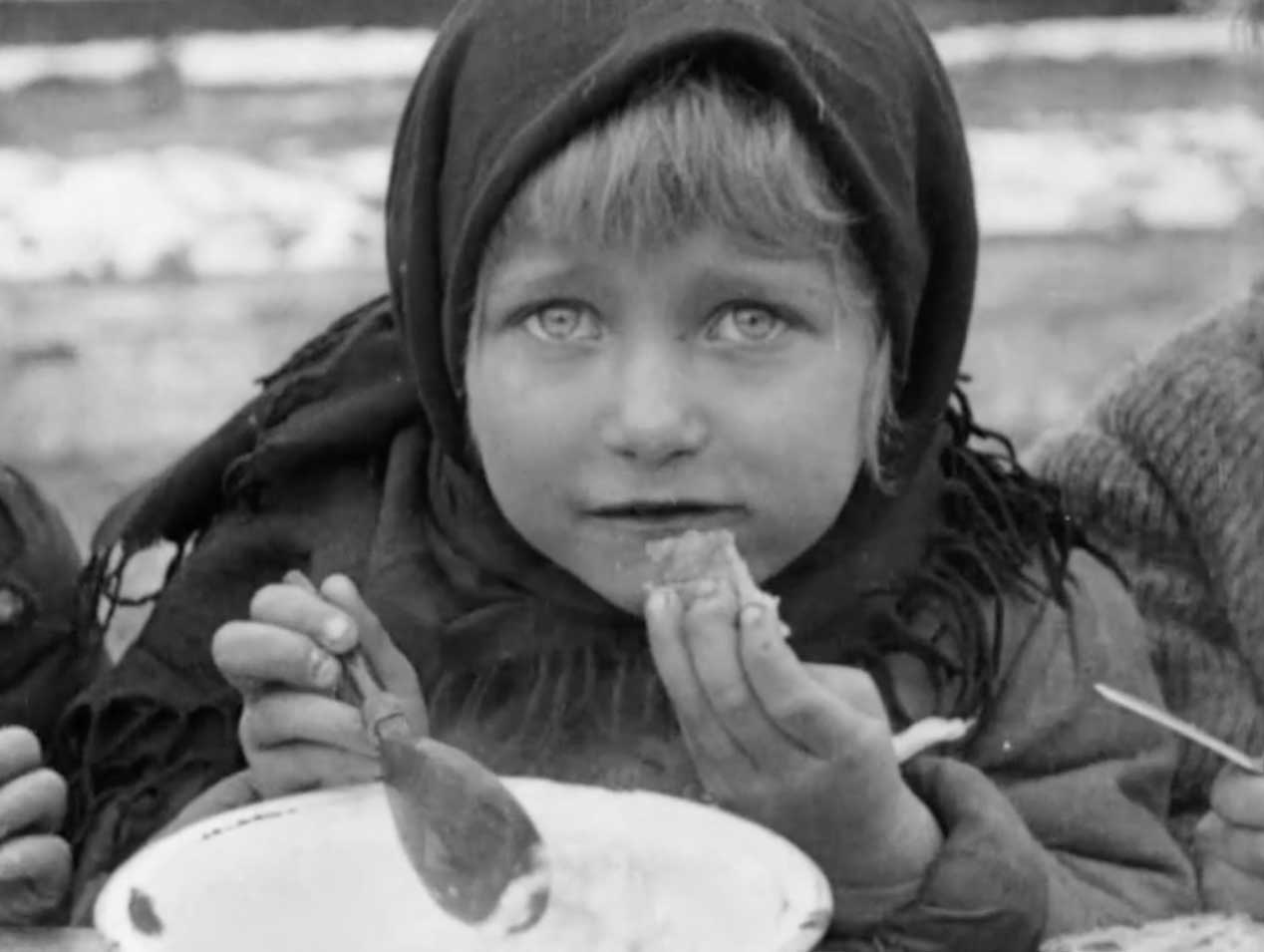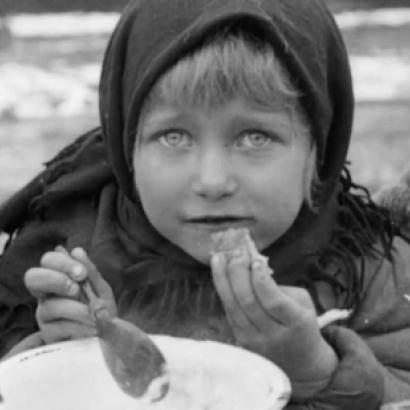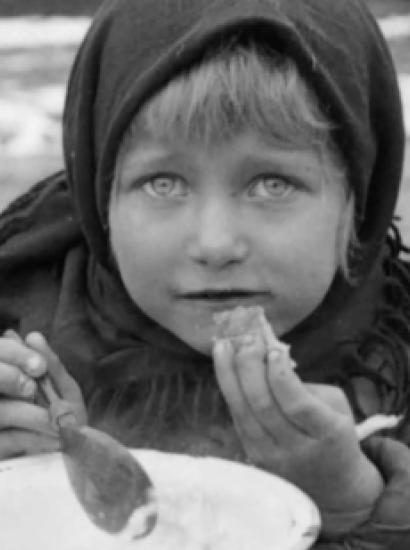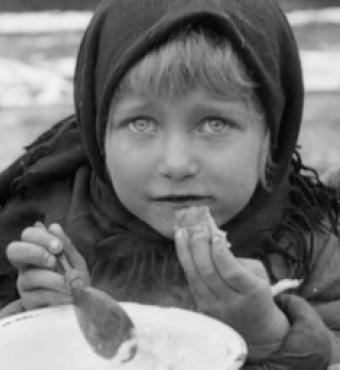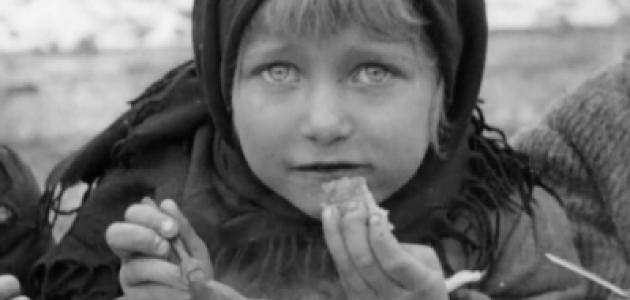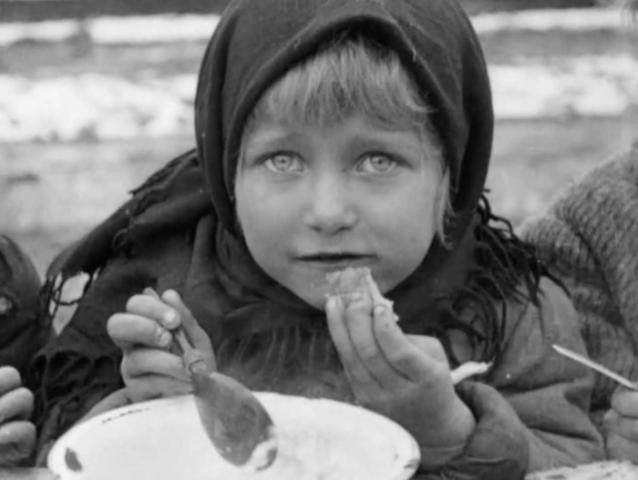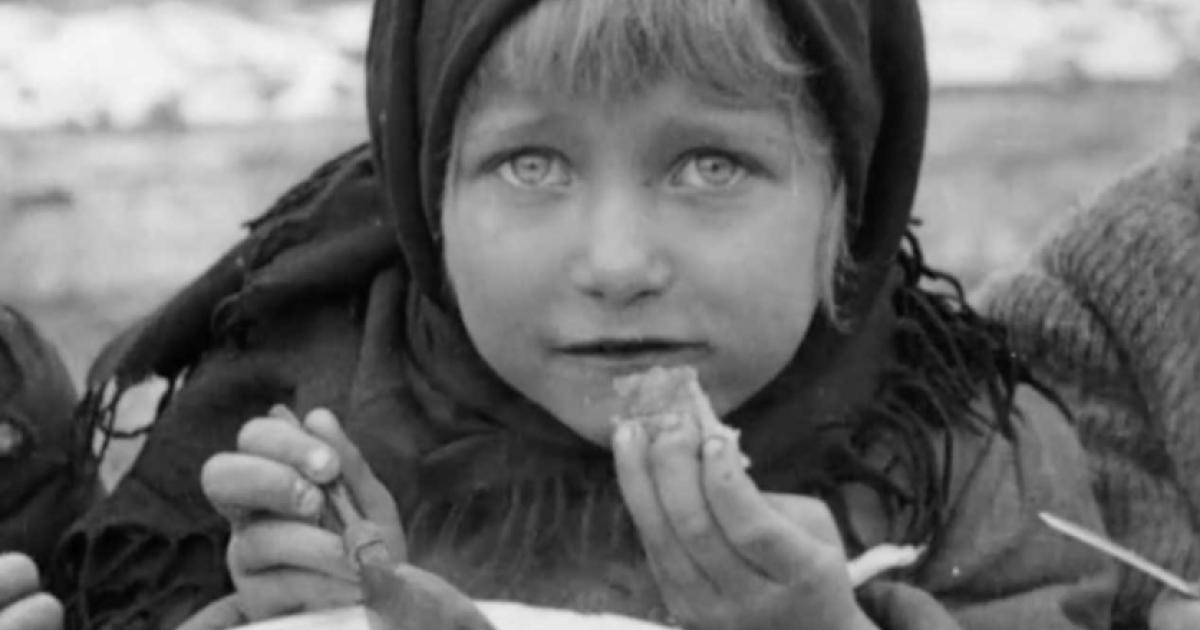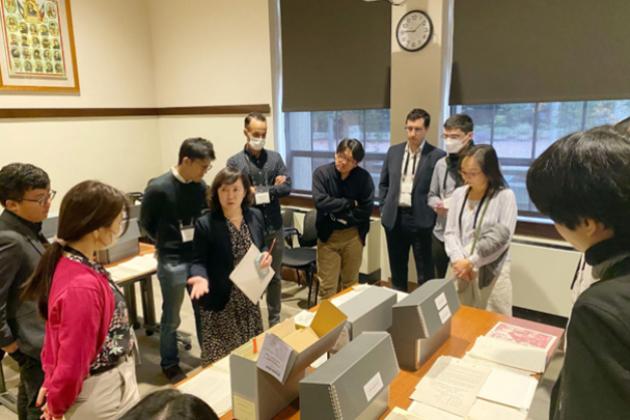

America's famine relief mission to Soviet Russia in 1921–22 was chronicled in photographs and motion pictures taken by Floyd Traynham, a young cameraman from Atlanta, Georgia. Traynham's films of American food being transported across the frozen Volga River and fed to hungry Russian children on the edge of starvation were shown in movie theaters across the United States. In 1922, a two-reel (22-minute) feature was compiled from Traynham's movies. On May 2, that film, "America's Gift to Famine-Stricken Russia," had its first public screening in a century. The film was accompanied by the performance of a string quartet of students from the Stanford Department of Music, with music arranged by cellist Jonathan Pak.
To learn more about Floyd Traynham you can view the digital story "A True Picture of Famine and Revival: Floyd Traynham, ARA Cameraman." It is part of the online exhibition Bread + Medicine: Saving Lives in a Time of Famine.
>> Samira Bazorgi: Welcome to all of you joining us this evening in Halk Auditorium on the beautiful campus of Stanford University. And to those of you joining us live online, we are grateful for your time and attention, my name is Samira Bazorgi. I'm the head of engagement and outreach at the Hugh Institution Library Archives, and I'm so excited to share that tonight will be the first ever film screening and musical performance in health since its opening in 2015.
Tonight's special program is presented in conjunction with the exhibition Bread and Medicine, Saving Lives In a Time of Famine. Now on view, we've extended it to May 21st in Hoover Tower, and it's also available forever online, via the Hoover Library and Archives website. It recognizes the centennial of the food and medical relief operation in Soviet Russia and Ukraine, led by the founder of the library and archives, Herbert Hoover, and the exhibition itself is based on the records of this relief effort, which were among the first collections to arrive here on campus to establish this library and archives.
I would love to take a moment to thank the friends and supporters of the library and archives without whom we could not fulfill our mission to collect and preserve access to some of the world's most important materials on war, revolution, and peace, political, economic, and social change in the modern era.
A few housekeeping notes for tonight, the film and performance will run about 23 minutes, and will be followed by a Q & A. So, for our online audience, please use the chat to submit your questions at any time. And for those of you in the room, we will have colleagues with microphones.
So, just raise your hand during the Q and A period and we'll try to get to everyone. This program is being recorded and will be made available to you online later in the week. So, it is my distinct pleasure to introduce you to my friend and colleague, Burt Patenaude.
As you can tell already, we've had a little bit of a program shift. Bert worked with our exhibition team to curate the exhibition in the tower, and he is here to help set the scene for tonight's film screening and performance. Bert is a research fellow at the Hoover Institution Library and Archives and a lecturer at Stanford.
His first book, the Big Show in Bolo Land, the American Relief Expedition to Soviet Russia and the Famine of 1921, when the 2003 Marshall Shulman Book Prize, and was made into a documentary film for the PBS history series, American Experience. He is also the author of Trotsky, Down the Fall of a Revolutionary and a wealth of ideas, revelations from the Hoover Institution Library and Archives, and a forthcoming companion publication for this exhibition which will be coming out June 1st.
So, Bert is joining us remotely, and I will hand things over to him, thank you all.
>> Bert Patenaude: Thank you, Samira, good evening, everyone. I wanna begin by thanking a few people myself. First of all, Eric Waken, the director of the Hoover Librarian and Archives. I want to thank him for his support of the entire Bread and Medicine project, of which this speaker series is merely a part.
Two people I wanna thank for technical assistance with the film, one is Lynn Smith of the Herbert Hoover Presidential Library, and the other, our very own Kurt Hickman of Stanford News service. Big thanks to those two for helping us get the film to look the way it should, to Janet Marshall, Lisa, and our events team, major thanks for organizing an event with a lot of moving parts.
To Jonathan Pack, thank you for being such a genial collaborator. And I have to say our collaboration on this project really did begin in the classroom in the winter quarter of 2022 in a seminar called Famine in the Modern World. And finally, we all owe a debt of gratitude to Samira for inspiring this event.
Now, a few words about the film, and I wanna set your expectations here by saying that this is not an art film, it's a two reeler, so 22 minutes in length. It was put together in the late summer of 1922 by the American Relief Administration, the ARA, by the office staff in New York City, New York City headquarters, shortly after the decision was made to continue the relief mission in Soviet Russia for a second year.
So originally, the mission got underway in August 1921, they thought they would stay for a year. They were gonna stay for a second one, so the map that you're looking at, shows you the extent of the relief activities. It says medical districts, but it really works for both the food and the medicine.
So, the film that you're gonna see was not intended to convey the horrors of the famine. And, in fact, by the time the film was made, the back of the famine had already been broken several months before in the spring of 1922, with the arrival of the American corn, and the wheat seed that was planted and then saved the harvest of 1922.
The film's purpose rather, is to emphasize the remedy of American food and medicine, you'll see this, the message was, your American relief workers have the job at hand. So, the film was screened for select gatherings, members of the press, representatives of some of the affiliated agencies, organizations, ARA affiliated organizations such as the Quakers, the Jewish Distribution Committee.
It was screened as a way to build support for, and perhaps raise additional funding for the relief mission. The film is a compilation of scenes captured by a cameraman, the ARA cameraman, Floyd Trainum. He spent January to May of 1922 in Soviet Russia documenting the famine, and the relief activities.
Trainum, really an unlikely cameraman in Soviet Russia, he was a native of Atlanta, Georgia, and had for some years been a staff photographer at the Atlanta Journal, and he proved to be the right man for the job. He got along well with the organization, he would return to Soviet Russia the following year.
He'd be there the first half of 1923 to document the ARA's reconstruction efforts, and the revival of the country that had since been reconfigured as the Soviet Union, the USSR. In addition to his motion pictures, Trainum took several thousand still photos, which are part of the American Relief Administration operational records in the Hoover archives.
Many of these have been digitized and they are in fact viewable online. Most of the film sequences that you're gonna see had been bought by the newsreel companies and distributed to more than 1800 movie theaters across the US in the first half of 1922, so they had a lot of visibility.
The compilation jumps around at the timeline, there are some awkward transitions in expert editing, it is not a polished production, not by our standards. In fact, if you're paying close attention, you'll probably cringe once or twice, that's healthy, that's normal. Title cards, of course, will situate the action, and among the scenes you will see are these, the unloading of American supplies in the Porta Petrograd.
You look at the map, you see it in the extreme northwest there today called St Petersburg. You'll see scenes of child feeding, the feeding of a daily supplemental meal to children. Which was really the core activity of the ARA in the 15 countries that operated in before it entered Soviet Russia in 1921.
In 1921, in December 1921, the decision was made to expand the mission to include adult feeding. This was supported by US congressional appropriation of $20 million, and that was used to purchase mostly corn from the American Midwest. So, what you will see, and it's pretty impressive, is the transportation of corn and seed and other supplies in March 1922, in caravans across the frozen Volga River.
Now, if you're looking at the map, I can help you trace the line of the Volga, in the north, you can follow it, there's Kazan. Follow it down south to Simbirsk, Samara, Saratov, and then Tsaritsyn. And at that point, the Volga takes a hard turn left into the Caspian.
So, that's the Volga, and there's also the trans Volga. So, east of the Volga, and you see Ufa and Orenburg. This is the area where the famine was really centered, this is what the Americans call the famine zone. Now, there was also mass starvation in Ukraine, more about that in a minute.
In the sequences of the transportation of the supplies, you will see camels, lots of camels, working hard to transport those supplies into the interior, into the towns and the villages. Everything you see that's being transported came from the American Midwest. Still, I marvel at it when I think about it, quite a logistical feat, they got it all the way there, and then they got it into the interior.
We go into the interior, and we see the distribution of corn, in one town, the town of Vasilyeva, in Samara province. This is a scene very stagey, it's put together by an ARA publicity person who was on the scene, a guy named Harry Gilcrest. He's seen pumping the hands of the frail beneficiaries that he's meeting like a politician on the stump.
Today we will find it cringe worthy, but obviously they didn't find it that way back in the summer of 1922. The film's title refers to Russia, America's gift of famine-stricken Russia. The country was popularly known at the time as Soviet Russia, this is before the formation of the Soviet Union in December 1922.
And Soviet Russia, and that's the name we chose for the map we made for the exhibition as you see there, Soviet Russia was a confederation of republics, Russia being the largest, but also Ukraine and Byelorussia, really at the top of the hierarchy, each technically independent. Only in Ukraine was there serious famine outside Russia proper, this was southern Ukraine, you see it there along the Black Sea coast, that was especially hard hit.
And in the film, you'll see children lined up for a meal in Odessa. And actually, the film returns to an end with a farewell scene in Odessa. Now, much of the action in the film takes place in Tsaritsyn, on the lower Volga, you can find it on the map there.
And that includes the sequence that features the star of the film, the little girl whose image you see on the announcement for this event. Watch for her in the queue of children receiving their portion of Kasha. So, rice, porridge and bread, it's at an outdoor field kitchen, and we'll a little bit later catch up with her eating her meal, seated on a bench at a table.
So, Tsaritsyn, two decades later, especially on and after June 22, 1941, when the Germans launched their invasion of the USSR. The veterans of the American relief mission would follow the headlines, and they would ponder what effect their mission may have had a on the unfolding events. And as the eastern front approached the Volga, especially in February 1943, after the great Soviet victory at Tsaritsyn, which had since been renamed Stalingrad.
The Americans recalled their life saving efforts two decades earlier, and they wondered what connection there might be between then and now. Children fed and fortified by the ARA had repaid a debt to America, even if unwittingly, by halting the German advance, that's certainly an interesting way to think about it.
And finally, finally, when I discuss this famine relief mission, as I've had occasion to do over the years. It's almost inevitable that I'm confronted by questions about the earlier allied military intervention in Soviet Russia during the Russian civil war in 1918-1920. The idea is that somehow the military intervention dilutes or nullifies or neutralizes the effect of the later famine relief mission, casts a shadow over the motivations behind it maybe.
Khrushchev, Nikita Khrushchev made this point when he was in Hollywood in 1959, that was the old Soviet line, it continues today under Putin. Today it's about how US imperialists had always been against the Russian people, had always been trying to keep the Russians down. But let's be clear about one thing, no matter how you present the allied military intervention, and militarily, it had little effect, very little effect, on the outcome of the Russian civil war.
The worst that could be said about it is that it was directed against a political regime, the soviet regime, not a people. In 1921, on the other hand, the goal of the American Famine Relief Mission was to rescue a people in spite of the ruling Soviet regime. The American relief workers had no love for the Soviet system of government.
They frequently clashed with obstructionist Soviet officials, but they separated the rulers from the ruled and kept their focus on saving the lives of Soviet citizens whom they called the Russians. Back in Washington, Herbert Hoover, as chairman of the ARA, had to deal with skeptics. One of whom wrote to him from Louisville, Kentucky, in May 1922, quote, seems to me that in helping Russia, we are strengthening a dangerous enemy.
Hoover responded, quote, I think you will need to separate in your mind the 200,000 communists in Russia from the 150 millions of Russian people. It's a point that I think we should keep in mind today in resisting the easy Russophobia that's been going around. Okay, that's some background, now please join me in welcoming our student musicians, Jonathan Pack, Audrey Lynn, Bradley Moon, and happy birthday, Roger Shaw.
>> Samira Bazorgi: I know I started by saying that was the first musical performance here in Hawke, but I'm pretty sure you've made sure that it's not the last. And thank you so much for really making the archives feel alive today, I don't think that was a really special performance.
I think I wanted to ask you, we're all curious to know what inspired your selection of the four musical pieces in the program.
>> Jonathan Pack: Yeah, so I guess it was really important to Professor Patenaude and I that it was kind of like Russian music written by Russians of a time period that it would have been congruent with what's going on in terms of the film.
And we especially wanted to make sure that the Tchaikovsky piece was on there, both in terms of kind of it being one of our favorite pieces, but also just to push against the notion that Putin is claiming that America has canceled Tchaikovsky and whatnot, which is just untrue.
>> Samira Bazorgi: So, for most of us, we don't really know what it means to arrange music. That you can speak a little bit about what it means to arrange music, and what in particular were some of the special challenges of matching music to this film.
>> Jonathan Pack: So, I guess for this film, I guess it's a little disjointed in terms of kind of the moods that are throughout the film.
And so, I guess that was the big challenge, in terms of arranging, it wasn't so hard the first half, because it was actual string quartet music. So, I didn't need to really touch anything, but the bridging between the stuff, especially just to modulate to the correct key, was a little tough, but I hope it sounded all right.
>> Samira Bazorgi: Now, you cofounded the Stanford Medicine Orchestra. Can you tell us what the Stanford Medicine Orchestra is, and how you got involved in launching it?
>> Jonathan Pack: Yeah, so my cello teacher is Chris Costanza, and he was contacted by people in the School of Medicine and Stanford Hospital. And they were looking to create an orchestra comprised of doctors and nurses and other affiliates of Stanford medicine.
And so, it was through Chris that I essentially got the appointment as the conductor, the first conductor kind of person is coordinating concerts and whatnot. And so, we had our first concert last fall, and we've had another concert in the spring, just at the beginning of spring. And so, yeah.
>> Samira Bazorgi: So, now we take some questions from our virtual audience, and then for those of you in the room, Bert is here on the he can hear us, and he can hear you. So, if you have questions for Bert about the film, the exhibit, or anything, as well as the musical arrangement, Jonathan will be here with us.
So, I will ask first if we have any questions from folks joining us online.
>> Audience 1: One question online, the film said that children were getting their daily meal, did they just get one meal per day? That's maybe a question for Bert.
>> Bert Patenaude: And it is a question for Bert, and the answer is yes.
The idea initially, when Hoover was considering this mission, was that they would come in and feed a daily meal to a million children. Pretty quickly, once the mission began, they upped that total to 3 million. And Herbert Hoover was very careful about what he committed his program to, and he was always very careful to have it stipulated that it was a supplemental meal.
The idea is not to create a kinda dole for people, to get society on track, to reestablish its own lines of production and ways of feeding itself. So, this was called a supplemental meal, but as you can imagine, this was an essential meal, usually served in the middle of the day, and it was the life-saving meal.
It was the meal that, even though to us, I mean, it's cocoa and porridge, maybe some corn grits and some bread and milk. Nobody's idea of a balanced meal, but it was a lifesaver, and eventually the numbers would increase. And once the corn begins to come in, those people who were receiving the corn, you saw that in line, they were standing in line there in Vasilyevka.
The corn is basically distributed, and they can prepare it how they wish. But also, the Americans were serving corn grits as part of a daily meal for adults. And so, the total figure, the figure that very much impresses is by August 1, 1922, the ARA, the American Relief Administration, was feeding about 10.5 million Soviet Russian citizens a day.
That's kinda long answer to the question, but yes, there you go.
>> Audience 1: Was it true that a deal was struck between the Harding administration and Lenin's government to allow the ARA in, in 1921, that included the release of American prisoners in Soviet Russia who had been accused of spying, among others?
>> Bert Patenaude: Yeah, so that's correct that there was a deal. So, when Hoover was preparing to go in, when Maxim Gorky sent his telegram asking for bread and medicine, and the Americans, they were ready for this moment. And Hoover, they basically started pressing all the right buttons and go, go, go, and let's get in there.
They thought this would happen at some point, but Hoover insisted that before the ARA could go in, that the Soviet government would have to release, and I forget the exact number. Maybe the question said a dozen, it could be that many. I think it's about eight or ten Americans accused of spying, there were a couple in there that could legitimately be accused of espionage, others were just people who got swept up.
A filmmaker was in there, and a couple of other people who had no business being in prison. But basically, Hoover said, we won't come in until you free the Americans. The Harding administration had really nothing directly to do with this. The State Department, under Secretary of State Charles Evans Hughes, was very supportive of what Hoover was doing and was backing him up, but Hoover could insist on this and get his way.
So yeah, so those prisoners were freed, and the Americans, the last of them, as the Americans were coming in at the end of August in 1921. Let me actually say one thing there to Jonathan, or about the thing Jonathan was answering about the selections. So, the Tchaikovsky piece, the Andante Cantabile, is one of our favorite pieces.
And the interesting thing about that is it was inspired by the early 19th century, The Song of the Volga Boatmen. And I think if you listen to the two side by side, some of you can probably hum The Song of the Volga Boatmen in your head, and you can, if you play the Tchaikovsky, you get where that came from.
Tchaikovsky had arranged that for an orchestra early in his career, apparently. And anyway, you can see the inspiration there, so I thought it was especially appropriate. I was delighted when I saw that Jonathan had put it on the program.
>> Audience 2: We don't think of corn as, even in that time, a European grain, and especially now your Russian, how did that work out?
>> Bert Patenaude: Yeah, that's a good question, so the deal was this, once the Congressional appropriation of $20 million goes through, the US Congress doesn't stipulate that that has to be spent on corn. But Herbert Hoover knows that with so much grain and other agricultural products available in surplus, corn is the one that is available in the greatest surplus and would give you the biggest bang for your buck.
So, and the line at the time was that farmers are burning corn for fuel, it's just being wasted. So basically, buy corn at the best price and send it over to Russia. So, and that had some people scratching their heads in Moscow, a little bit, they wondered if, and I mean, the Americans of the ARA, wondered if corn would go over, would it work?
Would the Russians know how to prepare it? And there's some very funny stuff that goes on once Hoover announces that it will be corn. You have people saying look, the Russians don't know corn, and sending in recipes, here's how to make cornbread. And here's my recipe for corn pancakes and other things, very funny stuff.
And it turns out that at the other end, there were some instances, and you could see one of the kids was putting his hand through a bag of corn kernels there, hand milled and chewing on one or two, and there were instances where people were eating underprepared corn, and suffering the consequences.
But generally, it went very, very well, now part two of that is that there was going to be an additional amount sent over. This was going to be $10 million that the soviet government put up from its gold supply. And that was going to be used, Hoover insisted they do this, that would be used for seed.
And Hoover said, corn seed, and that's when word reached Moscow, and Colonel Haskell said, no way. There's no way that you're gonna get corn, the Russians to plant corn, having them eat it as a one off in order to get through the famine is one thing, but planting it won't work.
And it's Colonel Haskell and the people around him who say, what you need is wheat seed from the northern parts of the American Midwest, that's what the Russians will know how to grow, that's what will have the most successful crop. And Hoover saw the light, but a good question about corn.
>> Audience 3: Did they have fuel to cook the corn, or was that a problem as well?
>> Bert Patenaude: Good question, I never run into a question of whether they'll have fuel to prepare the corn. Certainly, the American kitchens had plenty of fuel, it never comes up, really. It was more a question of where they were going to mill it.
And you see there's this big windmill in the background in the Vasilyevsky scene. But as far as preparing it and where they're gonna get the fuel for cooking and so on, never. I don't think I ever encountered a document that pointed to that being a problem but thank you for the question.
>> Josh: Thank you, I noticed for me the images that made the biggest impression on me were the children eating. And so, I was wondering if there was any coordination between the ARA and the schools to help feed children through institutions that they were already enrolled in.
>> Bert Patenaude: Absolutely, and I think that was Josh asking that question.
Absolutely. Absolutely, and that's a very good question. And, in fact, this is the American Relief Administration, and Hoover called this organization that for a reason. These American relief workers were administrators, there were not many of them that went into these various countries at any one time. In Soviet Russia, there were only 200 maximum, 300 over the course of the two year mission.
So essentially, they are administering relief, and in order to do so, they are hiring a humongous staff. In Soviet Russia, it's about 120,000 people, locals, and these would be everything from transportation workers, warehouse workers, kitchen inspectors, and dining hall inspectors. And so, what they found that they could do to great benefit is set up kitchens inside the schoolhouses, and that would do a couple of things, that would provide them with the staff to oversee the quality control of the food as it was being prepared.
Is the rice too thin, is the rice too thick, are they mixing the cocoa in with the rice? That happened occasionally, basically, let's make sure that the food is being prepared properly. And also though, they're trying to determine which children are eligible or most eligible to receive a daily meal.
And it might be the girl you saw in the scene in Tsaritsyn, the cover girl for our poster for the announcement, but maybe not her sister at home who's not needing a daily ration. So, how are you gonna regulate this? You need personnel who know the people who are coming in, who can tick the names off the roster, schoolteachers.
And the final benefit here is kids come to the school, they get their daily meal, and they get their daily lessons. So, it's one of the, I'm glad, Josh, you asked the question, because it's something that I often forget to mention. The ARA bringing in its relief and organizing it the way it does, gets Soviet society up and running again in so many ways that the notion of food or bread and medicine doesn't really get across.
And this is one of them, and I'll end on this, but the tributes to the American relief workers, to the ARA, to the United States, to Herbert Hoover, tributes by the hundreds, I would say thousands, in the American Relief Administration Russian operation. Papers, records, those tributes make it clear they're written by, and oftentimes included these very sorts of crude but endearing artworks done by four-year-old, five-year-old students.
They are the best indication that kids' lives were saved, but also, in many ways, their education, which had been held up by years of turmoil, was back underway. But thank you for that question.
>> Samira Bazorgi: Thank you, if you would all join me for another round of applause to thank our remarkable undergraduate orchestra.
>> Samira Bazorgi: For taking time away from their studies to join us, and that concludes our program.
Download the event program

ABOUT THE PARTICIPANTS
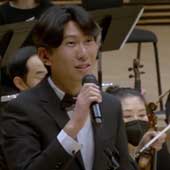
Jonathan Pak is a Stanford undergraduate ('24) majoring in International Relations and minoring in Music. He studies the cello with Christopher Costanza and conducting with Paul Phillips in the Stanford Department of Music. A native of Los Angeles who was raised in Phoenix, Jonathan is a founder of the Stanford Medicine Orchestra and conducted its inaugural concert in Bing Concert Hall in 2022. His fellow musicians for this event are Stanford undergraduates Roger Xia ('24, violin I), Audrey Lin ('25, violin II), and Bradley Moon ('25, viola). Musical arrangement by Pak and Jenny Xiong ('24).

Bertrand M. Patenaude is a research fellow at the Hoover Institution Library & Archives and a lecturer at Stanford University. His first book, The Big Show in Bololand: The American Relief Expedition to Soviet Russia in the Famine of 1921 (Stanford University Press, 2002) won the 2003 Marshall Shulman Book Prize and was made into a documentary film for the PBS history series American Experience. He is also the author of Trotsky: Downfall of a Revolutionary (HarperCollins, 2009) and A Wealth of Ideas: Revelations from the Hoover Institution Archives (Stanford University Press, 2006).
ABOUT THIS SERIES
The Bread + Medicine Speaker Series highlights conversations with historians of Russia and Ukraine and leading experts on famine and humanitarianism. It is presented in conjunction with the exhibition Bread + Medicine: Saving Lives in a Time of Famine devoted to the American famine relief mission to Soviet Russia in 1921–1923.



